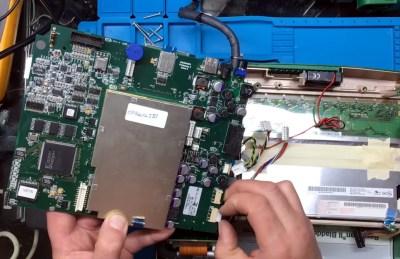Medical equipment often makes for interesting teardown videos: the strict requirements imposed by certification bodies mean you’ll find good quality components and a high standard of design and manufacturing. But when [Buy It Fix It] bought an ultrasound scanner on eBay, he wasn’t interested in tearing it down: his plan was to use it to find out if his sheep are in lamb, so he went on to repair it and modify it for its new purpose.
The device in question is a Mediwatch Bardscan II, which is meant to be used for scanning people’s bladders. The mainboard has a completely different model number however, which suggests that the basic design is used for several types of ultrasound scanners. The system is powered by an AMD Geode processor that runs Windows XP Embedded stored on a CompactFlash card, so examining the internal software is easy: the scanner interface even runs on a regular Windows PC.
 Several files on the internal drive point at hidden features, with filenames like
Several files on the internal drive point at hidden features, with filenames like kidney.dib and liver.dib indicating that the instrument can scan more than just bladders. The drive also holds several versions of the scanning app, as well as a .ini file in which lots of features can be enabled or disabled. By running the executable through x32dbg, [Buy It Fix It] was even able to recover the password to enable the “Advanced Settings” menu — it’s “u10” in case you were wondering.
With a bit of file editing, [Buy It Fix It] managed to turn the rather basic system into a way more flexible ultrasound scanner. For example, he can now adjust the scan depth, replay previous scans and make notes on top of any captured images. It can even run DOOM, as he demonstrates at the end of the video — though we can imagine his sheep might not enjoy the sight of their owner approaching them with a box full of flame-throwing demons.
Medical ultrasound scanners, which have been around for quite a while, may appear to be complex machines, but it is possible to make a simple version with easily available components.
















Seeing it opened like that just makes you realise how important it is these items do get a chance to be reused/repurposed.
Way too good to rot in a landfill!
Or sold to another country on a budget.
They get used in the hospital till they break, get fixed then break again over and over. Eventually everyone gets mad enough to justify the extreme budgetary cost of replacing a hospital grade medical device. Then finally off to the landfill. I’m ok with this lifecycle, especially compared to consumer goods.
The lifecycle is based on how fast the technology evolves. Medical equipment has a rather strict regulatory process to follow and thus tends to lag behind other industries in certain ways, especially when there is overlap with quickly evolving industries such as information technology. Typical lifespan of the avg piece of medical equipment is around 7 years, with some items lasting much much longer. For example, Parks Pulse Dopplers which are this ultrasounds 2nd cousin, have been the same design for the past 15-20 years.
Once medical devices have either reached end of life or are being replaced as part of a larger modernization project, they are typically resold to a 3rd party company that will refurbish some of the equipment and then resell it along with unrepairable pieces for parts. Lastly, there are many humanitarian missions where older equipment that has no real value in the US medical system is often donated to 3rd world countries such has Haiti where it can still make a valuable contribution.